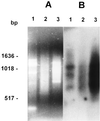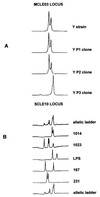Probing the genetic population structure of Trypanosoma cruzi with polymorphic microsatellites
- PMID: 9520443
- PMCID: PMC19913
- DOI: 10.1073/pnas.95.7.3776
Probing the genetic population structure of Trypanosoma cruzi with polymorphic microsatellites
Abstract
We describe here the identification of eight polymorphic microsatellite loci with (CA)n repeats in the Trypanosoma cruzi genome based on the affinity capture of fragments using biotinylated (CA)12 attached to streptavidin-coated magnetic beads. The presence of two peaks in PCR amplification products from individual clones confirmed that T. cruzi is diploid. Hardy-Weinberg and linkage disequilibrium analyses suggested that sexual reproduction is rare or absent and that the population structure is clonal. Several strains, especially those isolated from nonhuman sources, showed more than two alleles in many loci demonstrating that they were multiclonal. The phylogenetic analysis of T. cruzi based on microsatellites revealed a great genetic distance among strains, although the strain dispersion profile in the Wagner network was in general agreement with the species dimorphism found by PCR amplification of the divergent region of the rRNA 24Salpha gene.
Figures



Similar articles
-
The population structure of Trypanosoma cruzi: expanded analysis of 54 strains using eight polymorphic CA-repeat microsatellites.Mem Inst Oswaldo Cruz. 1999;94 Suppl 1:65-70. doi: 10.1590/s0074-02761999000700006. Mem Inst Oswaldo Cruz. 1999. PMID: 10677692
-
Evidence of substantial recombination among Trypanosoma cruzi II strains from Minas Gerais.Infect Genet Evol. 2014 Mar;22:183-91. doi: 10.1016/j.meegid.2013.11.021. Epub 2013 Dec 1. Infect Genet Evol. 2014. PMID: 24296011
-
Genome size, karyotype polymorphism and chromosomal evolution in Trypanosoma cruzi.PLoS One. 2011;6(8):e23042. doi: 10.1371/journal.pone.0023042. Epub 2011 Aug 12. PLoS One. 2011. PMID: 21857989 Free PMC article.
-
Genetic diversity and genetic exchange in Trypanosoma cruzi: dual drug-resistant "progeny" from episomal transformants.Mem Inst Oswaldo Cruz. 1999;94 Suppl 1:189-93. doi: 10.1590/s0074-02761999000700027. Mem Inst Oswaldo Cruz. 1999. PMID: 10677713 Review.
-
Trypanosoma and Leishmania have clonal population structures of epidemiological significance.Biol Res. 1993;26(1-2):47-63. Biol Res. 1993. PMID: 7545504 Review.
Cited by
-
Population Structure in Naegleria fowleri as Revealed by Microsatellite Markers.PLoS One. 2016 Apr 1;11(4):e0152434. doi: 10.1371/journal.pone.0152434. eCollection 2016. PLoS One. 2016. PMID: 27035434 Free PMC article.
-
A DTU-dependent blood parasitism and a DTU-independent tissue parasitism during mixed infection of Trypanosoma cruzi in immunosuppressed mice.Parasitol Res. 2014 Jan;113(1):375-85. doi: 10.1007/s00436-013-3665-z. Epub 2013 Nov 1. Parasitol Res. 2014. PMID: 24178748
-
Is sex better? Parasites say "no".Proc Natl Acad Sci U S A. 1998 Mar 31;95(7):3346-8. doi: 10.1073/pnas.95.7.3346. Proc Natl Acad Sci U S A. 1998. PMID: 9520366 Free PMC article. No abstract available.
-
Single-nucleotide polymorphisms of the Trypanosoma cruzi MSH2 gene support the existence of three phylogenetic lineages presenting differences in mismatch-repair efficiency.Genetics. 2003 May;164(1):117-26. doi: 10.1093/genetics/164.1.117. Genetics. 2003. PMID: 12750325 Free PMC article.
-
A Trypanosoma cruzi small surface molecule provides the first immunological evidence that Chagas' disease is due to a single parasite lineage.J Exp Med. 2002 Feb 18;195(4):401-13. doi: 10.1084/jem.20011433. J Exp Med. 2002. PMID: 11854354 Free PMC article.
References
-
- World Health Organization. WHO Tech. Rep. Series 811. Geneva, Switzerland: WHO; 1991.
-
- Macedo A M, Pena S D J. Parasitol Today. 1998;14:119–124. - PubMed
-
- Miles M A, Souza A, Povoa M, Shaw J J, Lainson R, Toye P J. Nature (London) 1978;272:819–821. - PubMed
-
- Miles M A, Lanham S M, de Souza A A, Póvoa M. Trans R Soc Trop Med Hyg. 1980;74:221–237. - PubMed
Publication types
MeSH terms
Substances
LinkOut - more resources
Full Text Sources

